Chameleons cannot be mistaken for any other lizards. The head and body are laterally compressed and the body is covered with small granular scales. Easily recognizable features include their diagnostic zygodactyl feet, in which adjacent digits are fused on each hand and foot, forming opposable grasping pads, and the presence of casques, horns, and crests on the heads of most species. The tail is usually prehensile and cannot be shed or regenerated. The protruding eyes can move independently. The tongue is telescopic and can be shot further than the body length to capture prey.
They change color easily and quickly, and their eyes, which are on protruding cones, can move independently of one another. Arboreal species have prehensile tails, and most species have laterally flattened bodies. Among the many synapomorphies of this group are extremely extensile tongues (due to modifications of the hyoid apparatus), failure of the pterygoid to meet the quadrate, a reduction in the number of sternal ribs, the loss of both the gular fold and femoral pores, and the V-condition of the ulnar nerve pathway. Like the agamids, but unlike other iguanians, chameleons have acrodont teeth. Chameleons range in size from tiny Brookesia (2.5 cm) to some very large Chamaeleo species (up to 68 cm total length).
Chameleons are primarily arboreal, but at least one South African species is terrestrial.
Chameleons are diurnal and primarily insectivorous, although birds have been recorded in the diets of some larger species. They can extend their tongues almost the entire length of their body, making their hunting behavior an impressive display. Chameleons exhibit a distinct locomotion in which they slowly rock back and forth between each step taken. Most species are oviparous. Several of the larger species show distinct sexual dimorphism, with males having larger body size, and elaborate horns and casques, with which they fight. Chameleons are not social animals, and when two animals have visual contact, they can change color within seconds. Depending on species, bright coloration may be restricted to males, found in both sexes, displayed only during the breeding season, or exhibited during aggressive encounters. Male displays may also include head jerking, the spreading of occipital lobes (if present), and gular sac extension. Sexual dimorphism in the dwarf chameleons (Rhampholeon in Africa) tends to run in the opposite direction, with females being the larger sex.
Africa Wild Reptile Book: Lizards - Photos & Descriptions
Moderator: Klipspringer
Re: AW Reptile Book: Lizards - Pics & Descriptions
Eastern Cape Dwarf Chameleon, Southern Dwarf Chameleon Bradypodion ventrale
Family: Chamaeleonidae. Subfamily: Chamaeleoninae
 © PJL
© PJL
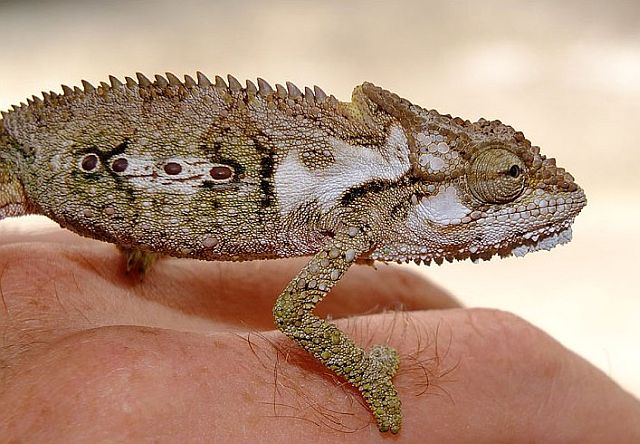 © PJL
© PJL
Port Elizabeth, Eastern Cape
Size
It is a relatively large species of dwarf chameleon, reaching lengths of 14 cm.
Description
It has a very prominent narrow and pointed casque on the back of its head and a long, beard-like large throat crest, scales overlapping. Tail short.
It has as large overlapping scaled gular lobes, and lateral rows of larger scales on flanks. Normal colors are brown and gray, and when excited males turn blue-black with rust colored stripes.
Geographic distribution
South Africa (Eastern Cape Province, Free State). This species has the largest distribution of any southern African dwarf chameleon, it has a wide distribution over large parts of the Eastern Cape and Great Karoo. The western limit of this species range is Beaufort West, the northernmost locality being Zastron and easternmost locality is Mthatha.

Habitat
This species is found in a broad range of habitats including mesic thicket, savanna and grassland mosaic, and temperate forest patches, however, it rarely enters fynbos. It adapts very well to living in suburban gardens.
Behavior
Arboreal.
Diet
Insectivorous.
Reproduction
Ovoviviparous. It gives birth to litters of between 10 and 20 babies in the summer.
 © PJL
© PJL
Addo Elephant National Park, Eastern Cape
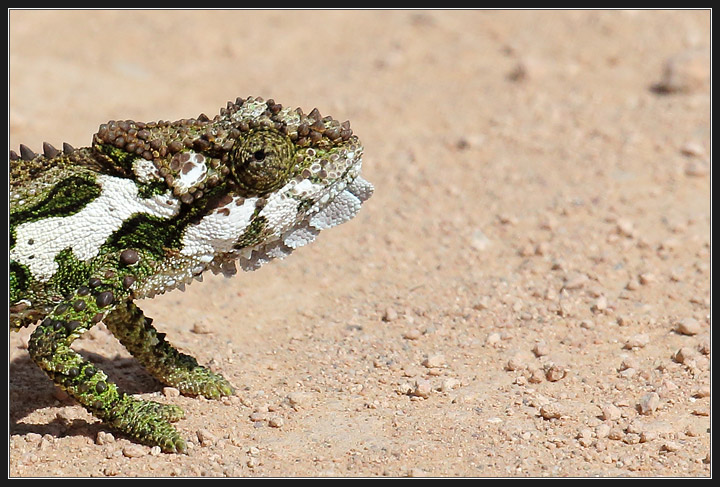
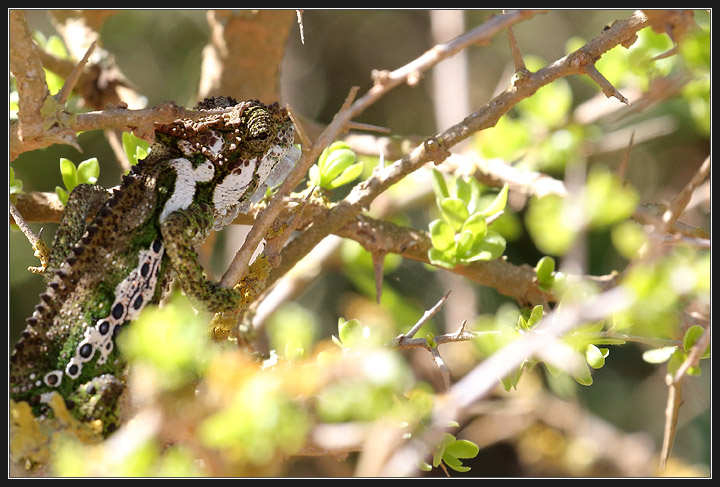 © PJL
© PJL
Addo Elephant National Park, Eastern Cape
Family: Chamaeleonidae. Subfamily: Chamaeleoninae
 © PJL
© PJL © PJL
© PJLPort Elizabeth, Eastern Cape
Size
It is a relatively large species of dwarf chameleon, reaching lengths of 14 cm.
Description
It has a very prominent narrow and pointed casque on the back of its head and a long, beard-like large throat crest, scales overlapping. Tail short.
It has as large overlapping scaled gular lobes, and lateral rows of larger scales on flanks. Normal colors are brown and gray, and when excited males turn blue-black with rust colored stripes.
Geographic distribution
South Africa (Eastern Cape Province, Free State). This species has the largest distribution of any southern African dwarf chameleon, it has a wide distribution over large parts of the Eastern Cape and Great Karoo. The western limit of this species range is Beaufort West, the northernmost locality being Zastron and easternmost locality is Mthatha.
Habitat
This species is found in a broad range of habitats including mesic thicket, savanna and grassland mosaic, and temperate forest patches, however, it rarely enters fynbos. It adapts very well to living in suburban gardens.
Behavior
Arboreal.
Diet
Insectivorous.
Reproduction
Ovoviviparous. It gives birth to litters of between 10 and 20 babies in the summer.
Addo Elephant National Park, Eastern Cape

 © PJL
© PJLAddo Elephant National Park, Eastern Cape
- Flutterby
- Posts: 43938
- Joined: Sat May 19, 2012 12:28 pm
- Country: South Africa
- Location: Gauteng, South Africa
- Contact:
Re: AW Reptile Book: Lizards - Pics & Descriptions
Flap-necked Chameleon Chamaeleo dilepis (Trapsuukie)
Family: Chamaeleonidae

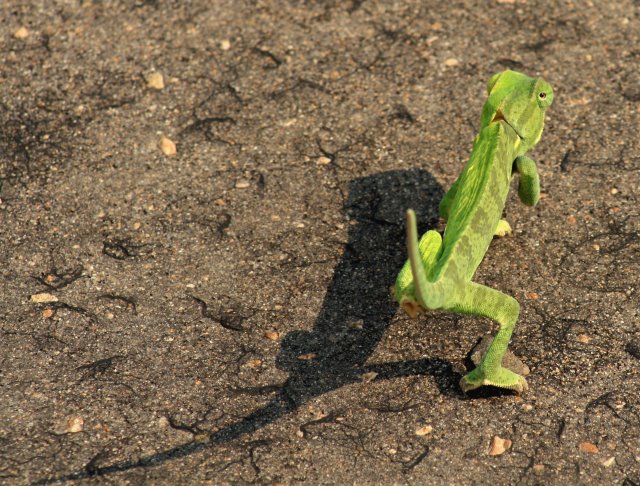

Description
The flap-necked chameleon is one of the larger chameleons that occur in South Africa, growing up to a maximum length of about 35 cm. It is essentially green, with a bright orange throat that it inflates in a defensive bluff. A diagnostic characteristic of the flap-neck chameleon are the occipital skin flaps behind the head. These skin flaps are larger and more prominent in the western sector of the population. Flap size varies and is dependant on age and sex, adult males having the largest flaps. It is these skin flaps that derive its name. The tail is long and prehensile, equal in length to its body, aiding in good balance and climbing stability. A further distinguishing feature is a throat crest which has small white scales that extend onto the belly, and the belly crest is white. Its overall colour may vary from green to pale yellow or brown, known to be able to readily change colour, especially when stressed – becoming quite dark in colour. Eyes are typically chameleon like and can be directed independently of each other. Each foot has five toes with a prominent claw on each. Gender identification is easy as the males have a distinct swelling at the base of their tails. On each hind foot the males have a small backward projecting spur.
Distribution
Central north and north eastern parts of our country.
Habitat
Forest, bush and grassland savannah.
Behaviour
When threatened, its body language is characterised by a gaping mouth which displays an orange colour lining. Simultaneously it raises the occipital flaps, inflates its body and rocks from side to side. It is reported to bite readily, though the bite carries no poison or venom. Hissing also occurs. They also change colour to regulate body temperature, for example darkening the body to absorb more solar radiation. The shadow side remains paler. During the cooler winter months flap-neck chameleons are more difficult to find as they become less active. It is unconfirmed, but in the much colder areas it is suggested they may hibernate, in underground tunnels. This may also serve as protection from grassland fires.
Diet
Mainly insectivorous, feeding on small insects such as flies, grasshoppers and beetles. During prey capture both eyes are directed forwards, creating binocular like vision. The long tongue which is sticky is used to catch prey. Tongue length equals body length when fully extended.
Predators
Predated on by large birds (recorded as prey of African cuckoo hawk and Augur buzzard), monkeys and snakes.
Reproduction
Mating season is in late spring – early summer when the male’s gular skin turns pale-white. Male rivalry is known and there is a further interstitial skin display amongst adult males. The females then permit approach from males, but courtship is brief before the actual act of mating takes place which may last up to an hour. For the female, egg development usually takes between 3 to 4 months, during this time the female presents a dull outer colour and is rather aggressive in nature. In late summer the female meticulously excavates a hole in damp soil before she lays her clutch of eggs which can total as many as 60. The hole is then carefully covered up and compacted. Egg incubation lasts from anything between 9 to 12 months, the young hatching and digging themselves out of the nest to reach the surface.
Links: Warren Schmidt: Reptiles & Amphibians of Southern Africa
 © Pumbaa
© Pumbaa
Kruger National Park
 © Amoli
© Amoli
 © nan
© nan
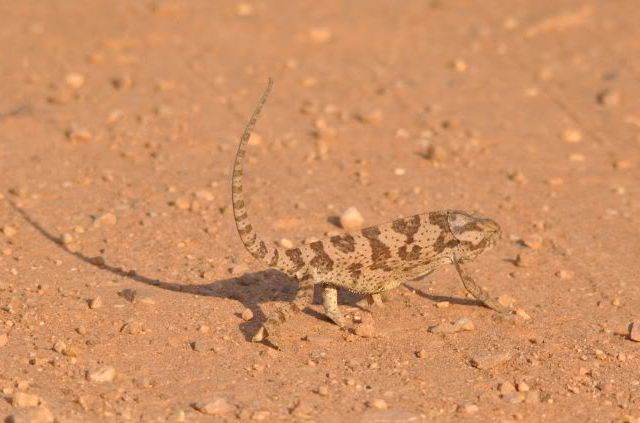 © lowveldboy
© lowveldboy
Family: Chamaeleonidae



Description
The flap-necked chameleon is one of the larger chameleons that occur in South Africa, growing up to a maximum length of about 35 cm. It is essentially green, with a bright orange throat that it inflates in a defensive bluff. A diagnostic characteristic of the flap-neck chameleon are the occipital skin flaps behind the head. These skin flaps are larger and more prominent in the western sector of the population. Flap size varies and is dependant on age and sex, adult males having the largest flaps. It is these skin flaps that derive its name. The tail is long and prehensile, equal in length to its body, aiding in good balance and climbing stability. A further distinguishing feature is a throat crest which has small white scales that extend onto the belly, and the belly crest is white. Its overall colour may vary from green to pale yellow or brown, known to be able to readily change colour, especially when stressed – becoming quite dark in colour. Eyes are typically chameleon like and can be directed independently of each other. Each foot has five toes with a prominent claw on each. Gender identification is easy as the males have a distinct swelling at the base of their tails. On each hind foot the males have a small backward projecting spur.
Distribution
Central north and north eastern parts of our country.
Habitat
Forest, bush and grassland savannah.
Behaviour
When threatened, its body language is characterised by a gaping mouth which displays an orange colour lining. Simultaneously it raises the occipital flaps, inflates its body and rocks from side to side. It is reported to bite readily, though the bite carries no poison or venom. Hissing also occurs. They also change colour to regulate body temperature, for example darkening the body to absorb more solar radiation. The shadow side remains paler. During the cooler winter months flap-neck chameleons are more difficult to find as they become less active. It is unconfirmed, but in the much colder areas it is suggested they may hibernate, in underground tunnels. This may also serve as protection from grassland fires.
Diet
Mainly insectivorous, feeding on small insects such as flies, grasshoppers and beetles. During prey capture both eyes are directed forwards, creating binocular like vision. The long tongue which is sticky is used to catch prey. Tongue length equals body length when fully extended.
Predators
Predated on by large birds (recorded as prey of African cuckoo hawk and Augur buzzard), monkeys and snakes.
Reproduction
Mating season is in late spring – early summer when the male’s gular skin turns pale-white. Male rivalry is known and there is a further interstitial skin display amongst adult males. The females then permit approach from males, but courtship is brief before the actual act of mating takes place which may last up to an hour. For the female, egg development usually takes between 3 to 4 months, during this time the female presents a dull outer colour and is rather aggressive in nature. In late summer the female meticulously excavates a hole in damp soil before she lays her clutch of eggs which can total as many as 60. The hole is then carefully covered up and compacted. Egg incubation lasts from anything between 9 to 12 months, the young hatching and digging themselves out of the nest to reach the surface.
Links: Warren Schmidt: Reptiles & Amphibians of Southern Africa
 © Pumbaa
© PumbaaKruger National Park
 © Amoli
© Amoli © nan
© nan © lowveldboy
© lowveldboyAfrica Wild Reptile Book: Lizards - Photos & Descriptions
Namaqua Chameleon Chamaeleo namaquensis
Family: Chamaeleonidae
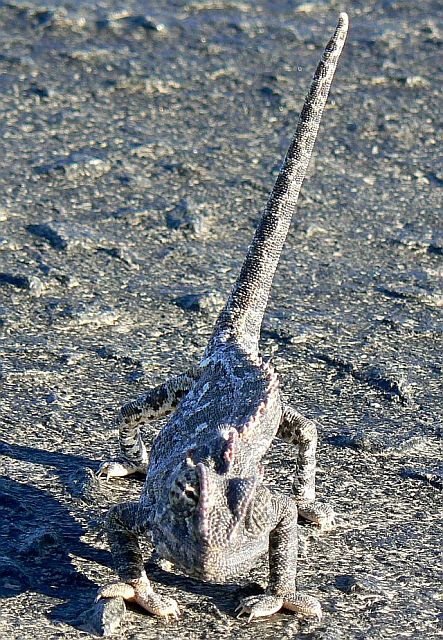

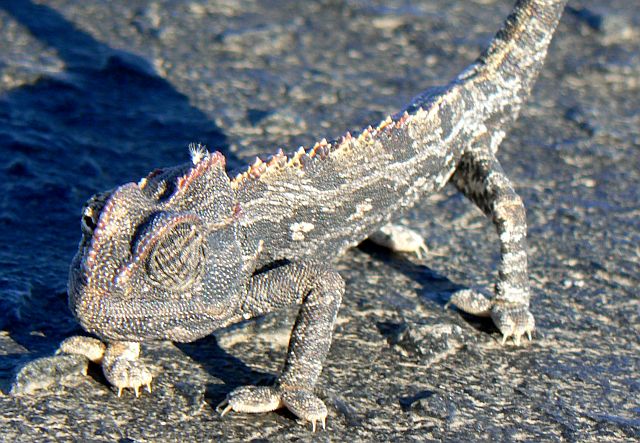
Size
Length of female: 16 cm. Length of male: 14 cm
Description
The Namaqua Chameleon (Chamaeleo namaquensis) is a little known but extraordinary species of chameleon, due to its habitat, feet, colour changing ability and speed.
It is a large bulky ground living chameleon with a large, triangular head with powerful jaws, conical, independently-moving eyes, laterally compressed body and fused toes, Particularly comical when walking, it has an odd gait, moving with diagonally opposite limbs. This species has a large head, a dorsal crest, a series of 12-14 large knobs along the backbone and a short tail which is not prehensile as it is in arboreal chameleon species It is capable of colour change, which is not only for camouflage as is generally assumed. It may also change colour in response to other chameleons (when fighting or mating), temperature, and their surroundings. Normally, the Namaqua chameleon is grey and brown with four to six lighter patches on its sides, dark triangles beneath the dorsal crest and red or yellow stripes on the throat.
Geographic distribution
The Namaqua chameleon is found in an area known as Namaqualand in western South Africa, as well as in southern Angola and the Namib Desert of Namibia.
Habitat
It occurs in desert and semi-desert regions (even along seashore), with low rainfall and temperatures ranging from 0ºC to 40ºC.
Behavior
Living in an inhospitable environment, the Namaqua Chameleon has evolved several adaptations to cope with desert conditions; they excrete salt from nasal glands to conserve water, and dig holes to aid in thermoregulation, to reach the cooler sand beneath, or may hide in burrows built by other animals. It will also stand on straightened legs to lift its body off the hot sand, a behaviour known as ‘stilting’.
Chameleons use specialised cells, called chromatophores, to change colour. Chameleons use this skill in different ways, for threat displays, mating displays and camouflage. However the Namaqua chameleon uses this evolutionary ace to control its body temperature. It can change some of its skin to white to deflect the sun and other parts a dark brown to absorb the sun. This helps to keep cool during hot days in an arid environment and keep warm during cold nights.
The Namaqua chameleon is an extremely fast runner, and uses its lengthy tongue to catch anything small enough to swallow. Most chameleons are arboreal and their feet comprise of five toes which are fuses into groups of three and two, which allow them to grip branches. The Namaqua chameleon can splay these ‘toes’ to allow it to run over flat ground.
Diet
Unlike the arboreal chameleons of the genus Chamaeleo, its tail is not prehensile, but otherwise it still hunts in the same way, slowly stalking its prey and catching it with its long tongue. Most chameleons are slow movers, they are ambush predators, but food is scarce in Namaqualand and when available fast moving. It eats, locusts, crickets, beetles, lizards and even small snakes (adders) and even scorpions, hunting them in both sandy dunes and rocky areas. But it feeds mostly on beetles and may eat up to 200 beetles a day. In order to catch these it can run at unusually high speeds for a chameleon. Namaqua Chameleons sometimes even prey on young chameleons of their own species.
Predators
Namaqua Chameleons are preyed upon by hawks, eagles and jackals. Adult Namaqua chameleons may even cannibalise smaller individuals of the same species.
Reproduction
Mating can take place up to three times a year, the larger female lays between 6 and 22 eggs per clutch in a sand burrow. The eggs incubate for three to four months in the sand, and females are thought to guard the laying site. Young Namaqua chameleons become reproductively active between five and seven months old.
Status
The Namaqua chameleon is classified as Least Concern (LC) on the IUCN Red List (1) and listed on Appendix II of CITES.
Links: Krystal Tolley, Marius Burger: Chameleons of Southern Africa
Video:
Family: Chamaeleonidae



Size
Length of female: 16 cm. Length of male: 14 cm
Description
The Namaqua Chameleon (Chamaeleo namaquensis) is a little known but extraordinary species of chameleon, due to its habitat, feet, colour changing ability and speed.
It is a large bulky ground living chameleon with a large, triangular head with powerful jaws, conical, independently-moving eyes, laterally compressed body and fused toes, Particularly comical when walking, it has an odd gait, moving with diagonally opposite limbs. This species has a large head, a dorsal crest, a series of 12-14 large knobs along the backbone and a short tail which is not prehensile as it is in arboreal chameleon species It is capable of colour change, which is not only for camouflage as is generally assumed. It may also change colour in response to other chameleons (when fighting or mating), temperature, and their surroundings. Normally, the Namaqua chameleon is grey and brown with four to six lighter patches on its sides, dark triangles beneath the dorsal crest and red or yellow stripes on the throat.
Geographic distribution
The Namaqua chameleon is found in an area known as Namaqualand in western South Africa, as well as in southern Angola and the Namib Desert of Namibia.
Habitat
It occurs in desert and semi-desert regions (even along seashore), with low rainfall and temperatures ranging from 0ºC to 40ºC.
Behavior
Living in an inhospitable environment, the Namaqua Chameleon has evolved several adaptations to cope with desert conditions; they excrete salt from nasal glands to conserve water, and dig holes to aid in thermoregulation, to reach the cooler sand beneath, or may hide in burrows built by other animals. It will also stand on straightened legs to lift its body off the hot sand, a behaviour known as ‘stilting’.
Chameleons use specialised cells, called chromatophores, to change colour. Chameleons use this skill in different ways, for threat displays, mating displays and camouflage. However the Namaqua chameleon uses this evolutionary ace to control its body temperature. It can change some of its skin to white to deflect the sun and other parts a dark brown to absorb the sun. This helps to keep cool during hot days in an arid environment and keep warm during cold nights.
The Namaqua chameleon is an extremely fast runner, and uses its lengthy tongue to catch anything small enough to swallow. Most chameleons are arboreal and their feet comprise of five toes which are fuses into groups of three and two, which allow them to grip branches. The Namaqua chameleon can splay these ‘toes’ to allow it to run over flat ground.
Diet
Unlike the arboreal chameleons of the genus Chamaeleo, its tail is not prehensile, but otherwise it still hunts in the same way, slowly stalking its prey and catching it with its long tongue. Most chameleons are slow movers, they are ambush predators, but food is scarce in Namaqualand and when available fast moving. It eats, locusts, crickets, beetles, lizards and even small snakes (adders) and even scorpions, hunting them in both sandy dunes and rocky areas. But it feeds mostly on beetles and may eat up to 200 beetles a day. In order to catch these it can run at unusually high speeds for a chameleon. Namaqua Chameleons sometimes even prey on young chameleons of their own species.
Predators
Namaqua Chameleons are preyed upon by hawks, eagles and jackals. Adult Namaqua chameleons may even cannibalise smaller individuals of the same species.
Reproduction
Mating can take place up to three times a year, the larger female lays between 6 and 22 eggs per clutch in a sand burrow. The eggs incubate for three to four months in the sand, and females are thought to guard the laying site. Young Namaqua chameleons become reproductively active between five and seven months old.
Status
The Namaqua chameleon is classified as Least Concern (LC) on the IUCN Red List (1) and listed on Appendix II of CITES.
Links: Krystal Tolley, Marius Burger: Chameleons of Southern Africa
Video:

Family Gekkonidae
The family Gekkonidae is represented by at least 82 genera and 870 species. Geckos comprise the second most diverse lizard family and occur throughout most of the world. Geckos posses a number of identifiable characteristics including a lidless eye covered with an immovable clear spectacle. Sub-digital lamellae (toe pads) are present on the ventral surface of the digits. The lamellae are comprised of several setae, each consisting of several branching hair-like projections 60 to 90 microns in length with expanded tips. These setae provide the geckos with their ability to “adhere” to vertical on smooth surfaces such as glass and sometimes upside down on ceilings. Most geckos are nocturnal and adorned with drab coloration. Geckos are capable of making and utilizing vocalizations. Males will audibly advertise their presence as both an open invitation to females as well as a warning to any wandering males. Whenever geckos are grabbed distress vocalizations are used. Perhaps this could startle a predator and provide the gecko with an opportunity for escape.
Re: AW Reptile Book: Lizards - Pics & Descriptions
Bibron's Thick-toed Gecko Chondrodactylus bibronii
Family: Gekkonidae
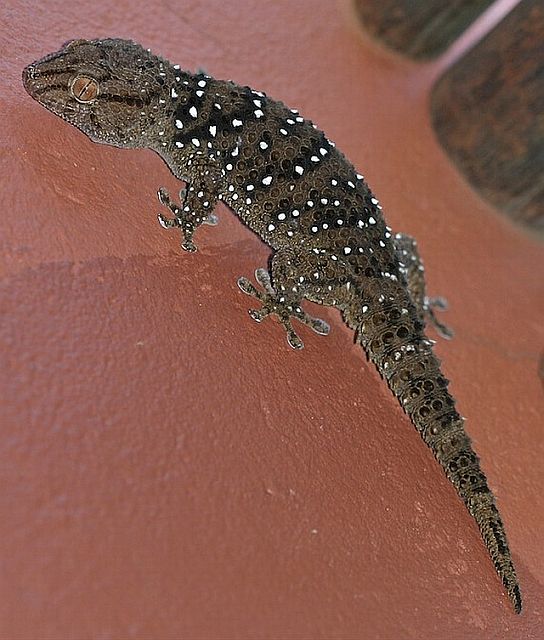 © ExFmem
© ExFmem
Description
Adult snout-vent length ranges from 7.5-10 cm, when fully grown. The female is generally smaller than the male.
It is a strongly stocky built gecko. The tail is about the same length as the body and is segmented, each segment consisting of regular, strongly keeled scales. The dorsal body is covered with large, keeled tubercles, separated by granular scales. The middle toes have 10-12 transverse lamellae underneath. It is olive to grey-brown in colour with 4-5 indistinct dark, wavy crossbands and scattered white dots. A dark band goes from the snout over each eye to the back of the head. The tail has 8-10 white bands, which is prominent in juveniles, but fade in adults. The belly is white or very light brown.
Bibron's Gecko is told from Turner's Gecko by having larger head scales, small mentals, and small eyelid scales.
Geographical distribution
Bibron's thick-toed gecko is one of the most common geckos in the southern African region (with the exceptions of coastal Mozambique; southern Transvaal; most of the Orange Free State; Lesotho and Natal, and some parts of the eastern and southern Cape).

Habitat Their favourite habitat is among rock crevices, cracks in walls, loose stones, thatched roofs, termite mounds, piles of leaves, in loose bark on trees.
Behaviour
They are a gregarious creature usually living in large colonies. They are very territorial geckos and males are quite aggressive towards each other. Territory and dominance fights are very common, leaving specimens without all their appendages. The species as a whole are fast runners, and tend to run right into bunches of leaves or rock outcroppings to hide.
Diet
Bibron's geckos feed on grasshoppers, beetles, termites, ants, smaller lizards and at times poisonous centipedes.
Predators
If attacked by a predator, usually birds, the Bibron's gecko sheds its tail quite easily, diverting the predators attention in order to escape. A new tail will grow to replace the original one.
Reproduction
The female Bibron's gecko will lay two hard-shelled eggs per clutch, leaving them in any convenient sheltered crevice or hole or under the bark of a tree, often in the communal nest. At least some females lay two clutches during the breeding season.

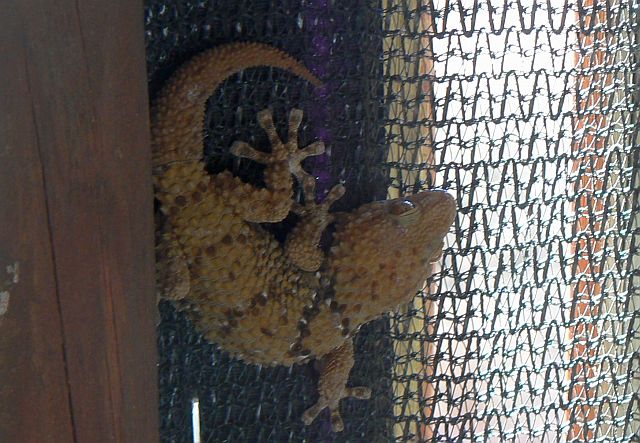
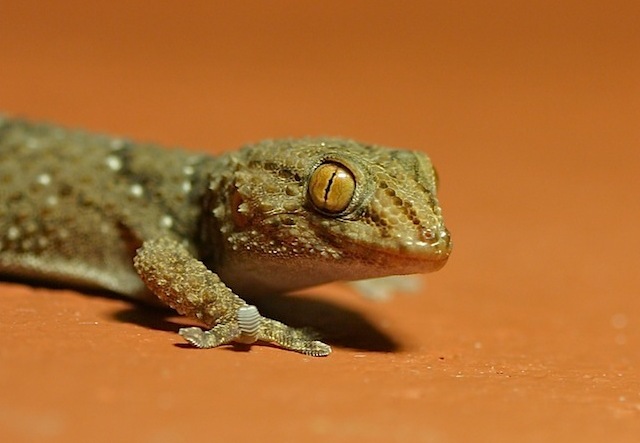 © ExFmem
© ExFmem
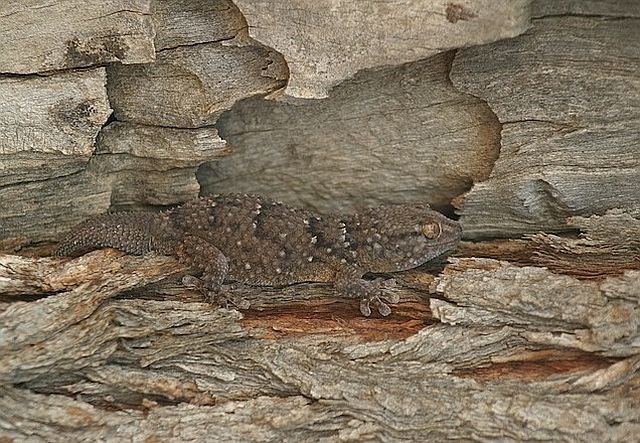 © ExFmem
© ExFmem
Family: Gekkonidae
 © ExFmem
© ExFmemDescription
Adult snout-vent length ranges from 7.5-10 cm, when fully grown. The female is generally smaller than the male.
It is a strongly stocky built gecko. The tail is about the same length as the body and is segmented, each segment consisting of regular, strongly keeled scales. The dorsal body is covered with large, keeled tubercles, separated by granular scales. The middle toes have 10-12 transverse lamellae underneath. It is olive to grey-brown in colour with 4-5 indistinct dark, wavy crossbands and scattered white dots. A dark band goes from the snout over each eye to the back of the head. The tail has 8-10 white bands, which is prominent in juveniles, but fade in adults. The belly is white or very light brown.
Bibron's Gecko is told from Turner's Gecko by having larger head scales, small mentals, and small eyelid scales.
Geographical distribution
Bibron's thick-toed gecko is one of the most common geckos in the southern African region (with the exceptions of coastal Mozambique; southern Transvaal; most of the Orange Free State; Lesotho and Natal, and some parts of the eastern and southern Cape).
Habitat Their favourite habitat is among rock crevices, cracks in walls, loose stones, thatched roofs, termite mounds, piles of leaves, in loose bark on trees.
Behaviour
They are a gregarious creature usually living in large colonies. They are very territorial geckos and males are quite aggressive towards each other. Territory and dominance fights are very common, leaving specimens without all their appendages. The species as a whole are fast runners, and tend to run right into bunches of leaves or rock outcroppings to hide.
Diet
Bibron's geckos feed on grasshoppers, beetles, termites, ants, smaller lizards and at times poisonous centipedes.
Predators
If attacked by a predator, usually birds, the Bibron's gecko sheds its tail quite easily, diverting the predators attention in order to escape. A new tail will grow to replace the original one.
Reproduction
The female Bibron's gecko will lay two hard-shelled eggs per clutch, leaving them in any convenient sheltered crevice or hole or under the bark of a tree, often in the communal nest. At least some females lay two clutches during the breeding season.


 © ExFmem
© ExFmem © ExFmem
© ExFmemAfrica Wild Reptile Book: Lizards - Photos & Descriptions
Turner's Thick-toed Gecko Chondrodactylus turneri
Family: Gekkonidae
 © Pumbaa
© Pumbaa
Kruger National Park
Description
SVL 65 to 85mm. Max SVL 95mm.
It is a large, stout gecko with a tail shorter than the body. It has a rough skin, composed of enlarged, keeled scales, separated by small granular scales; smooth tubercles on the back. Black-edged white spots cover the back.
The back is creamy olive to olive grey-brown with a number of wavy crossbands. The belly is white.
P. turneri is close to P. bibroni, it was previously considered as the same species. The differences are quite subtle between both species, they differ in their distribution range and in scale variations: mental scales are large in P. turneri, small in P. bibroni. It seems that only males P. bibroni have white spots on their backs, contrary to females which do not show such spots, and both sexes in P. turneri do not have these white spots.
Geographical distribution
Throughout the northern provinces of South Africa, Mpumalanga, and much of Namibia, Botswana and Zimbabwe.

Habitat
Bushveld.
Behaviour
This is a nocturnal species, tree- and cliff–dwelling, often found during the day under loose bark or in rock crevices. At twilight, they go out of their hides to forage for insect and other prey items.
Diet
Grasshoppers, beetles and ants.
Reproduction
Females lay 2 or 3 clutches of eggs consisting of 2 large eggs in a small hole dug in the sand or in rock cracks. Eggs hatch in 60 to 80 days.
Family: Gekkonidae
 © Pumbaa
© PumbaaKruger National Park
Description
SVL 65 to 85mm. Max SVL 95mm.
It is a large, stout gecko with a tail shorter than the body. It has a rough skin, composed of enlarged, keeled scales, separated by small granular scales; smooth tubercles on the back. Black-edged white spots cover the back.
The back is creamy olive to olive grey-brown with a number of wavy crossbands. The belly is white.
P. turneri is close to P. bibroni, it was previously considered as the same species. The differences are quite subtle between both species, they differ in their distribution range and in scale variations: mental scales are large in P. turneri, small in P. bibroni. It seems that only males P. bibroni have white spots on their backs, contrary to females which do not show such spots, and both sexes in P. turneri do not have these white spots.
Geographical distribution
Throughout the northern provinces of South Africa, Mpumalanga, and much of Namibia, Botswana and Zimbabwe.
Habitat
Bushveld.
Behaviour
This is a nocturnal species, tree- and cliff–dwelling, often found during the day under loose bark or in rock crevices. At twilight, they go out of their hides to forage for insect and other prey items.
Diet
Grasshoppers, beetles and ants.
Reproduction
Females lay 2 or 3 clutches of eggs consisting of 2 large eggs in a small hole dug in the sand or in rock cracks. Eggs hatch in 60 to 80 days.
Re: Lizards - Pics & Descriptions
Common Tropical House Gecko Hemidactylus mabouia
Family: Gekkonidae
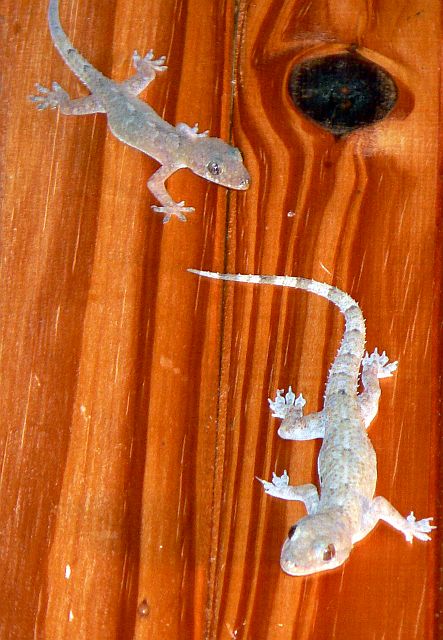
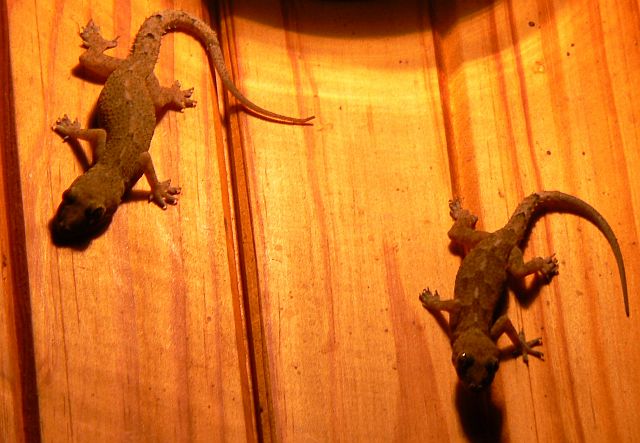
Kosi Bay, northern KwaZulu-Natal
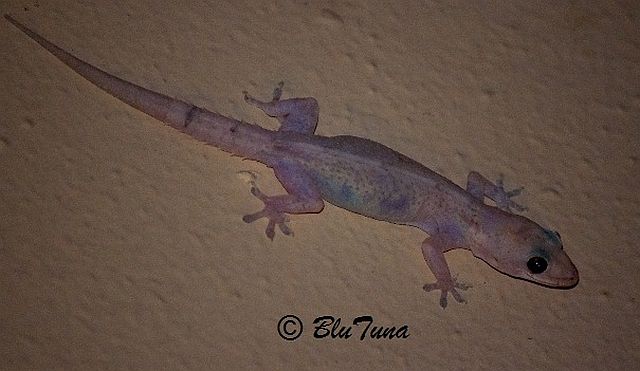 © BluTuna
© BluTuna
Crocodile Bridge, Kruger National Park
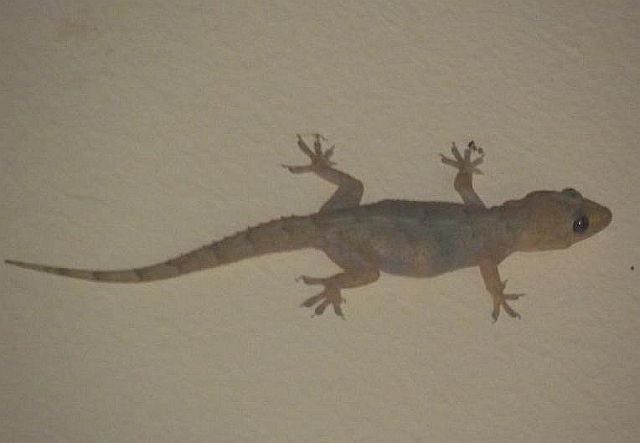 © mposthumus
© mposthumus
 © BluTuna
© BluTuna
House in Johannesburg
.
Size
The average adult can grow to a maximium of approximately 70 mm. Adult females usually have a head-body length between 61-70mm, whereas the male is shorter in length growing to between 58-67 mm.
Description
They are of a slender body type and have a flattened head which is considerably wider than the neck width. These lizards have a pointed snout from above and have small oval openings as ears. Dorsal scales or the upper surface scales (on the organism’s back) are very small and granular. They are interspersed with spike-like scales called tubercles which are positioned in longitudinal rows. Below the fingers and toes are a layer-like pattern of modified scales or lamellae. Lamellae help the lizard to cling on to any vertical surface e.g. a tree trunk. The tail is at least 20 mm of the head-body length and it is studded with granular scales and small tubercles. This species has exposed claws with toe pads.
It is able to change colour according to light intensity and temperature. Colours range from dark brown to greyish white or light brown. The tail is moderately colour banded.The entire body is almost translucent and is masked in black/brown V-shaped bands. Eggs can be seen through the ventral skin of females.
Geographic distribution
As its name suggests, this gecko is widely distributed in tropical Africa as well as further south into Namibia, Botswana, Transvaal, Swaziland and very common in the coastal regions of KwaZulu-Natal.It has been introduced to many other parts of the world.

Habitat
It is frequently associated with human establishments and is well known for utilizing areas around artificial light sources as hunting grounds.
Behaviour
This species is mainly nocturnal.
Diet
Insects (mainly moths). They practice the ‘sit and wait’ mechanism of capturing their prey.
Predators
Snakes (e.g. Brown House Snake).
Reproduction
The species Hemidactylus mabouia is oviparous. It lays two hard-shelled eggs.
Family: Gekkonidae


Kosi Bay, northern KwaZulu-Natal
 © BluTuna
© BluTunaCrocodile Bridge, Kruger National Park
 © mposthumus
© mposthumus © BluTuna
© BluTunaHouse in Johannesburg
.
Size
The average adult can grow to a maximium of approximately 70 mm. Adult females usually have a head-body length between 61-70mm, whereas the male is shorter in length growing to between 58-67 mm.
Description
They are of a slender body type and have a flattened head which is considerably wider than the neck width. These lizards have a pointed snout from above and have small oval openings as ears. Dorsal scales or the upper surface scales (on the organism’s back) are very small and granular. They are interspersed with spike-like scales called tubercles which are positioned in longitudinal rows. Below the fingers and toes are a layer-like pattern of modified scales or lamellae. Lamellae help the lizard to cling on to any vertical surface e.g. a tree trunk. The tail is at least 20 mm of the head-body length and it is studded with granular scales and small tubercles. This species has exposed claws with toe pads.
It is able to change colour according to light intensity and temperature. Colours range from dark brown to greyish white or light brown. The tail is moderately colour banded.The entire body is almost translucent and is masked in black/brown V-shaped bands. Eggs can be seen through the ventral skin of females.
Geographic distribution
As its name suggests, this gecko is widely distributed in tropical Africa as well as further south into Namibia, Botswana, Transvaal, Swaziland and very common in the coastal regions of KwaZulu-Natal.It has been introduced to many other parts of the world.
Habitat
It is frequently associated with human establishments and is well known for utilizing areas around artificial light sources as hunting grounds.
Behaviour
This species is mainly nocturnal.
Diet
Insects (mainly moths). They practice the ‘sit and wait’ mechanism of capturing their prey.
Predators
Snakes (e.g. Brown House Snake).
Reproduction
The species Hemidactylus mabouia is oviparous. It lays two hard-shelled eggs.
Re: AW Reptile Book: Lizards - Pics & Descriptions
Wahlberg's Velvet Gecko Homopholis walbergii
Family: Gekkonidae
 © mposthumus
© mposthumus
Description
A large velvet gecko. Length: 90 - 110 mm. The back is light to dark grey-brown, usually with irregular pale and dark crossbars, and often with a series of pale vertebral blotches. The snout lacks a black band. The belly is cream and is sometimes lightly spotted.
Distribution
H. wahlbergii has a broad distribution over Zimbabwe, eastern Botswana, southern Mozambique, Zululand, and the Limpopo Province of South Africa.

Habitat
This species is found in a variety of habitats, including coastal bush and mesic and arid savanna, and it can be found sheltering in a range of habitats such as under tree bark, in tree holes, rock overhangs and empty bird nests.
Behaviour
This species is nocturnal, but is occasionally seen during the day.
Diet
Its diet consists of insects, mainly beetles, grasshoppers and cockroaches, but it also eats termites and millipedes.
Reproduction
A pair of large, hard-shelled eggs are laid in a rock crack or under bark.
Family: Gekkonidae
 © mposthumus
© mposthumusDescription
A large velvet gecko. Length: 90 - 110 mm. The back is light to dark grey-brown, usually with irregular pale and dark crossbars, and often with a series of pale vertebral blotches. The snout lacks a black band. The belly is cream and is sometimes lightly spotted.
Distribution
H. wahlbergii has a broad distribution over Zimbabwe, eastern Botswana, southern Mozambique, Zululand, and the Limpopo Province of South Africa.
Habitat
This species is found in a variety of habitats, including coastal bush and mesic and arid savanna, and it can be found sheltering in a range of habitats such as under tree bark, in tree holes, rock overhangs and empty bird nests.
Behaviour
This species is nocturnal, but is occasionally seen during the day.
Diet
Its diet consists of insects, mainly beetles, grasshoppers and cockroaches, but it also eats termites and millipedes.
Reproduction
A pair of large, hard-shelled eggs are laid in a rock crack or under bark.
Last edited by ExFmem on Tue Feb 26, 2013 12:23 am, edited 1 time in total.
Re: AW Reptile Book: Lizards - Pics & Descriptions
Bradfield's Dwarf Gecko Lygodactylus bradfieldi
Family: Gekkonidae
 © Toko
© Toko
Mapungubwe National Park
Description
SVL: 25-30 mm.
The throat often has dark spots, the back is grey-brown with a pair of pale stripes, bordered by narrow, black lines on the flanks, the belly is cream.
Tail a little depressed, and indistinctly segmented, each segment having about 5 dorsal rows of scales; ventrally the segmentation is hardly traceable, but about 3 rows could be referred to each segment. The ventral scales are more or Iess of equal size and all a littie thickened. Tip of tail with about 4 pairs of modified adhesive scales.
Dorsal surfaces brown with thin black streaks, which may be much broken up and indistinct; one of these extends from the nostril to the eye and thence dorso-laterally to the inguinal region; another black streak commences at the angle of the mouth passes through the ear-opening to the axil; above the streak first mentioned a third streak extends from the neck to lumbar region, this streak sometimes starting from the eye; there are also traces of a pair of streaks in the mid-dorsal region. On the top of the head, black streaks form an indistinct open network There are also some white spots dorsally, the most distinct of which are 7 on each side dorso-laterally, between the two longest black streaks, and tending to form ocelli with the upper one. Throat sometimes immaculate, sometimes with faint spots and markings which occasionally form irregular streaks, but do not extend forwards to the chin region. Lower labials with blackish spots.
Distribution
Rare in South Africa, found only in the Limpopo Valley area and Northern Cape. Native to southern Angola, Zimbabwe, Botswana and the Republic of South Africa.
Habitat
Arid savanna and succulent desert. Mainly arboreal.
Reproduction
Clutches of two eggs, laid in hollow stems and under bark.
Field Guide to Snakes and Other Reptiles of Southern Africa. William R. Branch
Family: Gekkonidae
 © Toko
© TokoMapungubwe National Park
Description
SVL: 25-30 mm.
The throat often has dark spots, the back is grey-brown with a pair of pale stripes, bordered by narrow, black lines on the flanks, the belly is cream.
Tail a little depressed, and indistinctly segmented, each segment having about 5 dorsal rows of scales; ventrally the segmentation is hardly traceable, but about 3 rows could be referred to each segment. The ventral scales are more or Iess of equal size and all a littie thickened. Tip of tail with about 4 pairs of modified adhesive scales.
Dorsal surfaces brown with thin black streaks, which may be much broken up and indistinct; one of these extends from the nostril to the eye and thence dorso-laterally to the inguinal region; another black streak commences at the angle of the mouth passes through the ear-opening to the axil; above the streak first mentioned a third streak extends from the neck to lumbar region, this streak sometimes starting from the eye; there are also traces of a pair of streaks in the mid-dorsal region. On the top of the head, black streaks form an indistinct open network There are also some white spots dorsally, the most distinct of which are 7 on each side dorso-laterally, between the two longest black streaks, and tending to form ocelli with the upper one. Throat sometimes immaculate, sometimes with faint spots and markings which occasionally form irregular streaks, but do not extend forwards to the chin region. Lower labials with blackish spots.
Distribution
Rare in South Africa, found only in the Limpopo Valley area and Northern Cape. Native to southern Angola, Zimbabwe, Botswana and the Republic of South Africa.
Habitat
Arid savanna and succulent desert. Mainly arboreal.
Reproduction
Clutches of two eggs, laid in hollow stems and under bark.
Field Guide to Snakes and Other Reptiles of Southern Africa. William R. Branch


